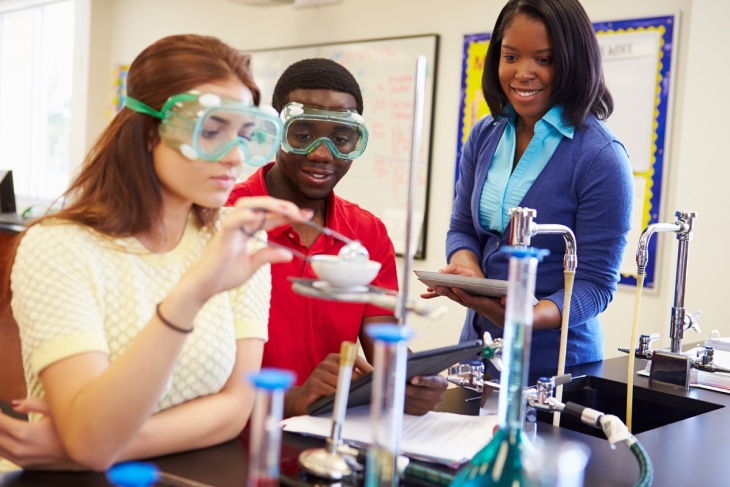The value of incorporating technology into secondary education courses is a matter of debate, but if there’s anywhere that it might be beneficial, it is most likely within STEM-related subjects—meaning that high schoolers might better see themselves pursuing science in the future if they are able to work with the same tools as professionals do in the field. Theorizing that any successful application of technology in teaching comes via the buy-in of teachers, a trio of researchers surveyed chemistry instructors to determine their views on the relevance, potential value, and ease of use of classroom technology. The findings and their implications are limited, but interesting.
The research team, led by Olivia Wohlfart, of the Karlsruhe Institute of Technology in Karlsruhe, Germany, interviewed ten chemistry teachers at the secondary level (students age twelve to eighteen) in Baden-Württemberg state, in the country’s southwest. They were of varying ages and had varying degrees of professional experience—both with chemistry education specifically and teaching generally. The interviewees were whittled down from an initial group who responded to an open call for participants, aimed at best representing the demographics of the state.
Baden-Württemberg was chosen because its chemistry education curriculum covers a diverse range of topics and activities spanning multiple grade levels. In secondary schools, chemistry is first introduced as a two-hour course in eighth grade, building upon the competencies acquired in earlier biology, natural sciences, and technology classes. In eleventh grade, chemistry becomes a core subject with three hours of instruction per week, and students may also opt to take it as a five-hour-long advanced subject. Chemistry curricula prioritize an experimental culture, the analysts write, placing a strong emphasis on hands-on learning and student research. Digital tools are incorporated into the curriculum to aid teaching and learning.
While the researchers clearly proceed from the view that students can benefit from the types of technology and instrumentation that lab chemists use in their daily work, it is the teachers’ attitudes toward that tech which forms the focus of the interview and analysis. Interviews took place in mid-2022.
While all ten teachers reported using technology in their classes, the most commonly cited digital tools in use were general applications for communication and organization purposes (think Microsoft Teams and spreadsheet software). Only four reported using chemistry-specific technology, such as digital data acquisition programs and molecule drawing programs like ChemSketch.
A majority of teachers reported positive feelings toward chemistry-specific technology, especially for illustrating complex or abstract concepts. Videos and “augmented reality” tools were cited as potentially helpful for visualizing the three-dimensional nature of atoms and the steps involved in chemical processes. Additionally, students could experience dangerous phenomena, such as nuclear chain reactions safely or time-compress slow chemical processes to better observe the outcomes using technology. Despite this positivity, however, teachers who felt that a given technology was difficult to use reported limiting its use in the curriculum. General tools, such as integrating videos (YouTube, Prezi, etc.), learning apps (like Kahoot), and digital displays (such as Apple TV or smart boards), were largely thought to be simple, quick, and intuitive—and were, thus, widely used. Beyond that, specific reported barriers—such as a perceived lack of tech support, unavailability of training, and/or a lack of student facility with a given technology—were strong factors in teachers’ decisions to avoid using a given application or software. Teachers who experienced problems with lower-level technology (Apple TV won’t work properly) were similarly deterred from regular use of higher-level technology, despite understanding the potential value of it. Responses did not vary with either teacher age or years of teaching experience.
Overall, Wohlfart and her team felt the interviewees indicated a “pragmatic, functional, and minimalistic attitude towards digital tools” in chemistry education. Technology could have a part to play, but even at its best, it was largely seen as a supplement to traditional teaching and experimental pedagogy. And once issues of unreliability came into play, even supplemental use could easily be halted by a given teacher.
Since the analysts are fully sold on the value of technology in secondary classrooms, rattling off a list of instruments and software both old and new that research shows add value to the study of chemistry at that level, their recommendations predictably focus on breaking down the barriers identified by German teachers: more training, more time in the day, more support from vendors and school administration. These are not the worst possible goals for German education leaders to pursue; however, it is interesting to note that other research into technology integration has called into question the value of technology usage as an end unto itself. Is removing barriers to having a working spectrometer in a high school chemistry course really where things should stop? Or would it be better to perhaps start with student outcomes—surveying those who pursued STEM education in college and attained employment in the research sciences—and work backward to make sure that courses and classrooms are equipped with everything they need to produce more of the same?
SOURCE: Olivia Wohlfart, Alina L. Wagner, and Ingo Wagner, “Digital tools in secondary chemistry education – added value or modern gimmicks?” Secondary Digital Education (June 2023).


